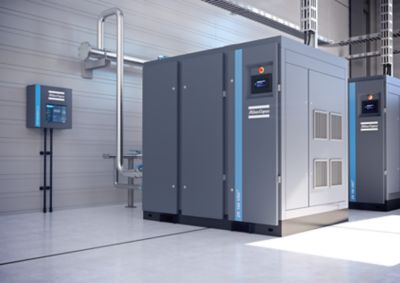The Dew Point Sensor in Compressed Air Technology
November 13, 2024
Find out everything you need to know about the importance and function of dew point sensors in compressed air technology.
What is a Dew Point? What is a Pressure Dew Point?
The dew point is the temperature at which the water content of the air is saturated and starts to condense. Similarly, we speak of a pressure dew point when the pressure level of the air is above atmospheric pressure. Therefore, the pressure dew point is the temperature at which water vapour condenses at a certain pressure.
The pressure dew point is an important parameter for determining the water content in compressed air. The lower the dew point, the drier the air.
What is a Dew Point Sensor, and How Does it Work?
A dew point sensor is used to determine the dew point of the air. In the field of compressed air technology, this is referred to as a pressure dew point sensor. It determines the pressure dew point of the compressed air.
The measuring device consists of a sensor that measures the temperature and water vapour content of the air or compressed air.
The dew point sensor works on the principle of condensation. The air is passed over the sensor and cooled until the dew point is reached. As soon as the dew point is reached, the water vapour condenses, and the sensor records the temperature. The dew point can be calculated based on this temperature.
The dew point is an indirect measure of the humidity level. The higher the dew point, the higher the humidity.
A practical example from compressed air technology:
If the ambient temperature of a compressed air line is below the pressure dew point in the line network, for example, the water vapour contained in the compressed air condenses. This can lead to problems such as corrosion, rust formation, and contamination. The use of a pressure dew point meter can therefore permanently ensure process reliability.
What Role do Dew Point Sensors Play in Compressed Air Systems?
Dew point sensors play an important role in compressed air systems as they help monitor and control the moisture content in the compressed air. Water content in the compressed air can lead to corrosion, wear and malfunctions in compressed air systems.
By using dew point sensors, the water content in the compressed air can be measured and monitored. This allows suitable measures to be taken to keep the water content at an acceptable level and prevent damage to the compressed air systems.
What are the Benefits of the Dew Point Sensor for the Compressed Air Station?
- Prevent condensation and corrosion: The formation of condensation can lead to corrosion, rust, and contamination. With the help of dew point measurement, you can ensure that the compressed air is sufficiently dried to prevent condensation.
- Optimization of the compressed air system: A dew point sensor can detect potential weak points in the compressed air system, such as leaks that can lead to condensation. By identifying and eliminating these weak points, you can increase the efficiency of the system and reduce costs at the same time.
- Ensure compressed air quality: Water in compressed air can affect the quality of compressed air and lead to malfunctions of compressed air tools and machines.A dew point sensor helps you to ensure compressed air quality by monitoring the dew point and ensuring that it is below a certain value.
- Save energy and costs: By accurately monitoring the dew point, you can make compressed air drying more efficient and therefore save energy.
Areas of Installation of Dew Point Sensors in Compressed Air Technology
Dew point sensors can perform a variety of tasks in different areas of compressed air technology. Their installation at certain locations makes it possible to fulfill specific functions. Here are some examples:
1. Installing the Dew Point Sensor Downstream of the Compressor:
If the dew point sensor is installed after the compressor, it can continuously monitor that the compressed air does not contain too much water before it enters the compressed air line or the compressed air dryer.
2. Installation of the Dew Point Sensor After the Compressed Air Dryer:
A dew point sensor at this point can help to monitor the quality of the dried compressed air and ensure that the dew point is below a certain level. Deviations may indicate a malfunction of the compressed air dryer.
3. Installation of the Dew Point Sensor at Critical Points in the Compressed Air Pipe Network
Dew point sensors can be installed at critical points in the compressed air pipe network, e.g. where the compressed air cools down. By placing one or more sensors at these points, the formation of condensation and associated problems can be effectively prevented. With multiple dew point sensors, faults can be better localized, allowing for easier diagnosis and troubleshooting.
When should a dew point sensor be installed in the compressed air system?
It is recommended to install a dew point sensor in the compressed air system when precise monitoring and control of the humidity in the compressed air is required.
Especially in environments where humidity can affect the quality of the compressed air, such as in the food and beverage industry or paint shops, the use of a dew point sensor is essential.
For precise selection, installation, maintenance, and calibration of a dew point sensor in your compressed air system, we strongly recommend consulting a specialist.

